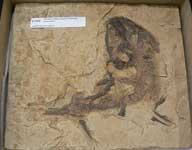Dissorophidae are an extinct taxon of medium-sized, temnospondyl amphibians that flourished during the Late Pennsylvanian and early Permian periods in what is now North America and Europe. Despite being amphibians, they seem to be well developed for life on land, with well-developed limbs, solid vertebrae, and a row of armour plates of dermal bone, which both protected the animal and further strengthened the backbone. A well known genus is Cacops, a squat solid animal from the late Early Permian (Artinskian age) Clear Fork group of Texas, with a relatively huge head, and a row of armor plates along the back. In the similar but slightly larger and more specialised genus, Platyhystrix, whose fossil remains are known from the Cutler Group of Utah, Coloardo, anfd New Mexico, the armor developed into a sort of ridge or sail. Not all Dissorophids were squat-bodied big headed animals. Fayella, from the late Artinskian of Oklahoma, was lightly built with long limbs, obviously relying on speed rather than armour plating as a defense against predators. There are a number of related forms which seem to have been more aquatic, which are known from the Late Permian of Russia and the Early Triassic of Gondwana. It has been suggested that the Dissorophidae may be close to the ancestry of Frogs, via intermediate forms like Doleserpeton. References * Anderson, J. M. & Cruikshank A. R. I. (1978), The Biostratigraphy of the Permian and Triassic, Part 5, a review of the classification and distribution of Permo-Triassic Tetrapods. Paleontol. Afr. 21: 15-44.
Retrieved from "http://en.wikipedia.org/" |
|

